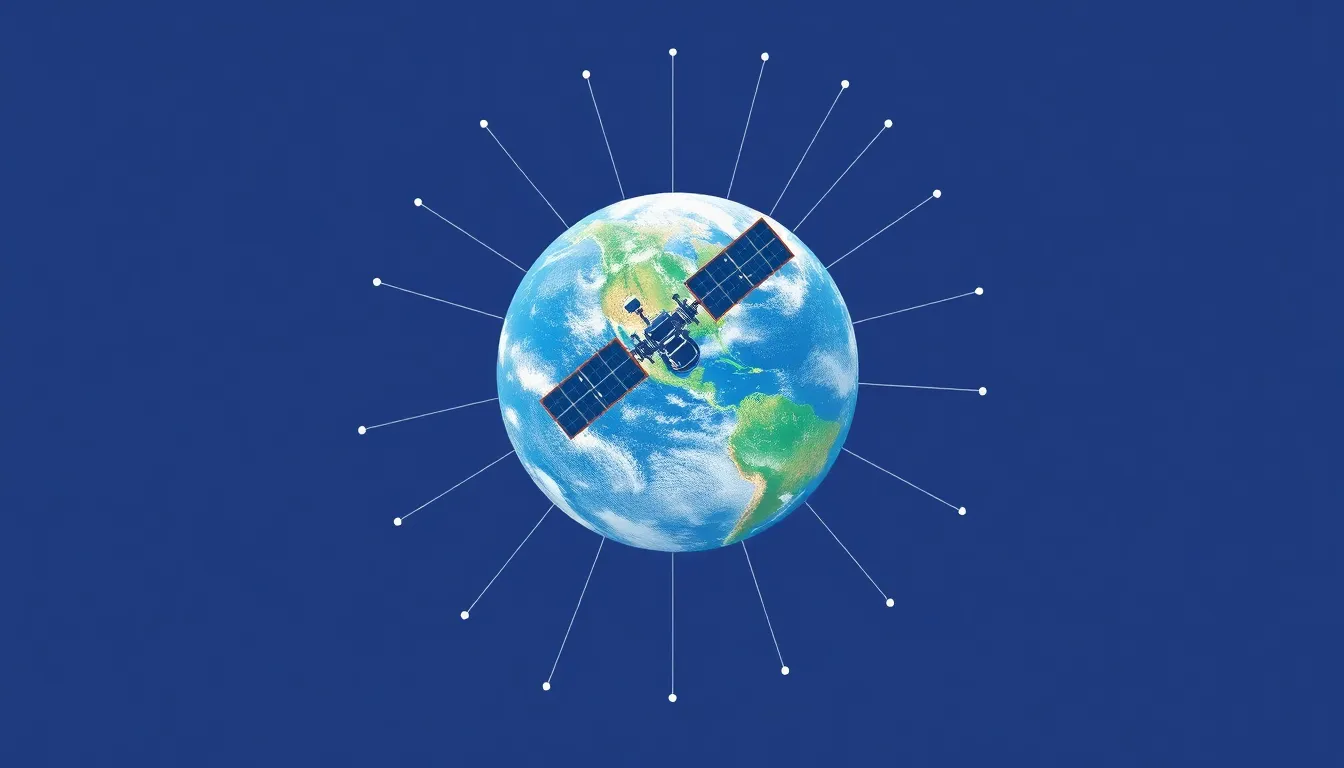In a world where instant communication is as vital as air, satellite communication swoops in like a superhero, connecting people across the globe with a wave of its invisible cape. Imagine chatting with a friend on the other side of the planet while sipping coffee in your pajamas—thanks to satellites, that’s not just a dream; it’s everyday life.
But let’s face it, satellites aren’t just high-tech Frisbees floating in space. They’re the unsung heroes behind everything from your favorite streaming service to emergency rescue operations. So grab your popcorn and settle in, because understanding how satellite communication works might just make you the smartest person at your next dinner party—or at least give you a great icebreaker.
Table of Contents
ToggleOverview of Satellite Communication
Satellite communication involves the use of satellites to transmit signals between different points on Earth. This technology utilizes a system of satellites, ground stations, and user terminals to facilitate communication. Satellites placed in orbit relay signals, enabling a range of applications including television broadcasting, internet access, and mobile communications.
Geostationary satellites orbit at approximately 22,236 miles above the equator. They match the Earth’s rotation, allowing them to stay fixed over a specific location. Such satellites provide wide coverage areas, often serving entire continents or regions. In contrast, low Earth orbit (LEO) satellites operate at altitudes between 100 to 1,200 miles. Their proximity to the Earth allows for lower latency and faster data transmission, making them suitable for real-time communication.
The role of satellite communication extends beyond entertainment. It supports critical services like disaster management, weather forecasting, and global navigation. For example, during natural disasters, satellites help coordinate rescue efforts by providing real-time data and communication channels. Military operations also rely on satellite communication for secure and effective coordination.
Understanding satellite communication is crucial as technology advances. With the rise of mega-constellations, such as SpaceX’s Starlink, the landscape of satellite communication is transforming. These systems aim to increase global broadband access, especially in underserved areas, bringing connectivity to millions.
Detailed knowledge about how satellite communication functions can enhance conversations about its impact. This technology shapes daily life, driving innovation across various sectors while maintaining critical connections worldwide.
Types of Satellite Communication

Satellite communication encompasses various types that fulfill distinct roles in global connectivity. Understanding these types contributes to grasping how satellite technology functions.
Geostationary Satellites
Geostationary satellites orbit at approximately 22,236 miles above the equator. These satellites maintain a fixed position relative to the Earth’s surface. They provide extensive coverage and are ideal for television broadcasting and weather monitoring. Latency issues are minimal, making them reliable for applications requiring consistent connectivity. Their wide-reaching footprint allows for effective communication across vast regions. Examples of services utilizing geostationary satellites include satellite television providers like DirecTV and emergency communication networks.
Non-Geostationary Satellites
Non-geostationary satellites operate at altitudes between 100 and 1,200 miles. These satellites move in low Earth orbit, allowing for reduced latency and faster data transmission. As a result, they offer advantages for applications like internet services and remote sensing. Mega-constellations, such as SpaceX’s Starlink and OneWeb, exemplify this type of satellite communication. Through a collaborative network of satellites, they aim to deliver broadband access even in remote areas. Their ability to provide service in regions underserved by traditional infrastructure makes them pivotal in expanding global connectivity.
Applications of Satellite Communication
Satellite communication serves multiple critical functions across various industries. These applications enhance connectivity and improve service delivery globally.
Telecommunications
Telecommunications heavily relies on satellite communication for voice and data transmission. Businesses benefit from enhanced connectivity in remote areas where terrestrial networks are limited or non-existent. Major telecom providers use satellites to deliver services such as mobile network connectivity and broadband internet access. Lower latency and improved bandwidth average around 30Mbps for LEO satellite systems, promoting seamless communication for users. Satellite links also support emergency communication services, ensuring that critical data reaches its destination even during natural disasters.
Broadcasting
Broadcasting stands as another prominent application of satellite communication. Television and radio stations utilize geostationary satellites to transmit signals over vast territories. This method allows broadcasters to reach millions of viewers without the need for extensive ground infrastructure. Wide coverage and the ability to deliver high-quality content are crucial features of this system. Major sports events and breaking news often reach global audiences via satellite, ensuring everyone stays informed and entertained. Additionally, satellite-based services provide uninterrupted content delivery, improving the overall viewer experience.
Remote Sensing
Remote sensing utilizes satellite communication for data collection and analysis from Earth’s surface. This application plays a significant role in environmental monitoring, agriculture, and disaster response. Satellites equipped with advanced sensors capture images and data, enabling accurate assessments of natural resources and climate change impacts. Scientists and researchers heavily depend on remote sensing data to monitor deforestation, crop health, and urban development. Governments and organizations use this information to make informed decisions, enhance resource management, and respond effectively to emergencies and changing environmental conditions.
Benefits of Satellite Communication
Satellite communication offers various benefits that enhance global connectivity and service accessibility.
Global Coverage
Satellite communication provides extensive global coverage. Geostationary satellites transmit signals across vast regions, allowing seamless communication in remote areas. This technology enables connectivity in regions where traditional infrastructure lacks, supporting industries like telecommunications, broadcasting, and disaster management. For example, rural communities can access vital services through satellite technology, bridging the digital divide.
Reliability
Reliability stands as a hallmark of satellite communication. Satellites maintain consistent connections, unaffected by terrestrial obstacles such as buildings and mountains. This characteristic ensures stable service even in extreme weather conditions or natural disasters. In emergencies, satellite communication proves invaluable, delivering real-time information and supporting coordination for rescue efforts. Businesses also rely on this dependable service for uninterrupted operations in diverse environments.
Accessibility
Accessibility remains a significant advantage of satellite communication. It grants users access to high-speed internet, voice, and data services across geographical barriers. Technologies like low Earth orbit satellites enhance this accessibility, providing lower latency and improved bandwidth. Developing regions benefit enormously, as satellite technology facilitates education, health services, and economic growth. Users in underserved areas can connect with the world, improving overall quality of life.
Challenges in Satellite Communication
Satellite communication faces various challenges impacting its effectiveness. Some of these challenges include signal delay and weather interference.
Signal Delay
Signal delay occurs due to the distance signals must travel between Earth and satellites. Geostationary satellites experience significant latency, with signals taking approximately 240 milliseconds for a round trip. Low Earth orbit satellites, positioned closer to Earth, reduce signal delay to about 20 to 30 milliseconds. This difference affects applications requiring real-time communication, such as video conferencing and online gaming. Understanding the extent of signal delay enables service providers to optimize their systems for specific use cases, ensuring better user experiences.
Weather Interference
Weather conditions can disrupt satellite communication, causing intermittent service and degraded signal quality. Rain, snow, and atmospheric conditions strongly influence signal strength, particularly for Ku and Ka-band frequencies. Heavy rainfall can lead to phenomena known as rain fade, which significantly diminishes signal clarity and strength. Storms and harsh weather can also obstruct line-of-sight communication. Engineers work on developing adaptive technology to mitigate these issues, improving resilience against adverse weather conditions. Awareness of weather interference helps users recognize potential challenges in satellite communications and adapt accordingly.
Satellite communication stands as a cornerstone of modern connectivity. Its ability to bridge gaps and provide essential services in remote areas highlights its significance in today’s world. As technology evolves and mega-constellations emerge, the potential for even greater access and reliability grows.
Despite challenges like signal delay and weather interference, ongoing advancements promise to enhance performance and resilience. Understanding the intricacies of satellite communication not only enriches knowledge but also fosters discussions about its impact on daily life. Embracing this technology will continue to shape the future, ensuring that global connections remain strong and accessible.





